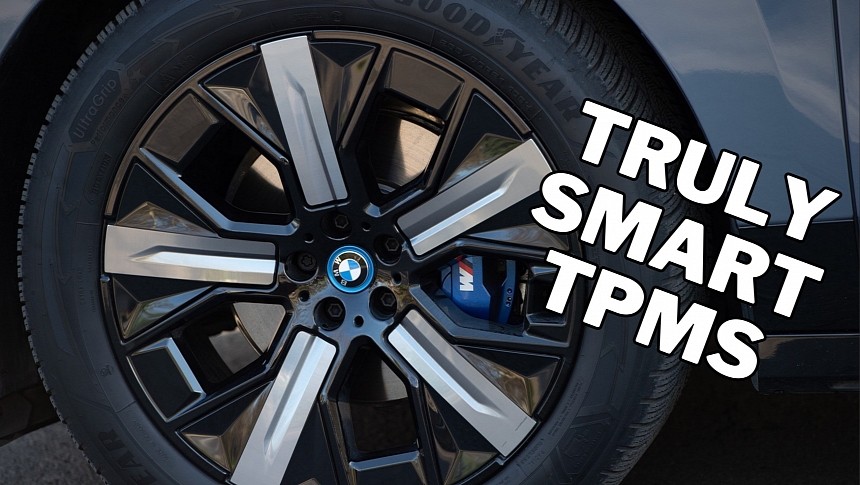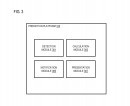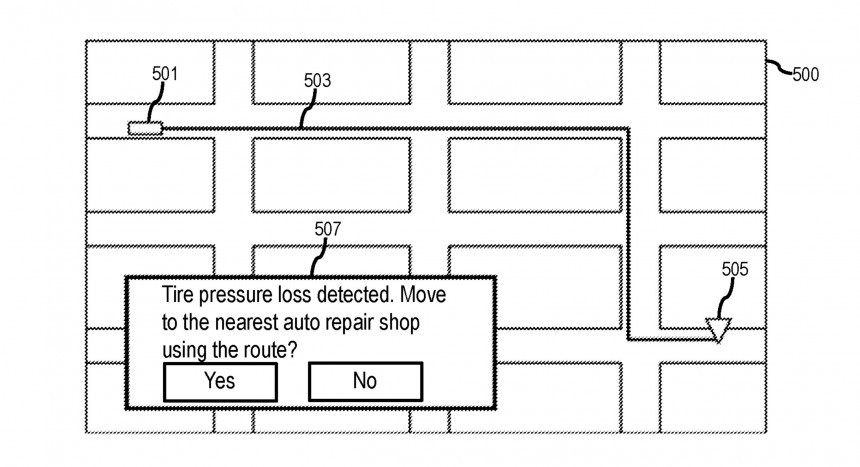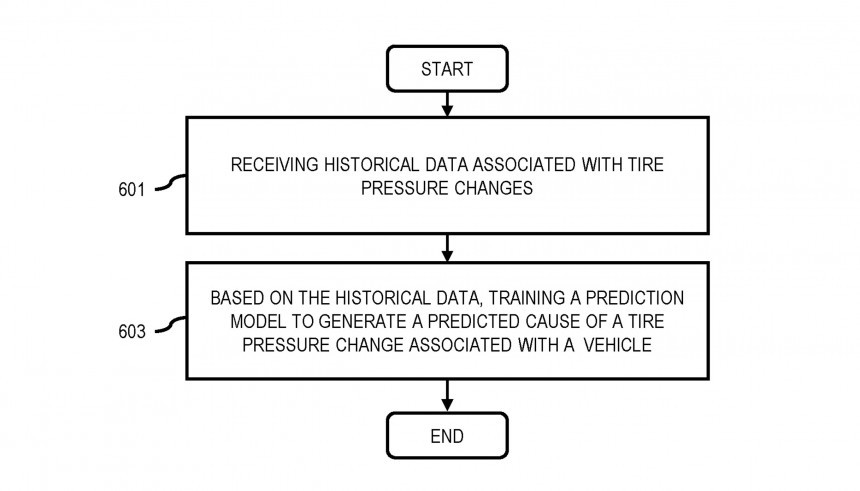Tire Pressure Monitoring Systems, often referred to as TPMS, are an incredibly helpful piece of equipment, as they keep an eye on your car's tires and send an alert whenever the pressure drops below a certain value.
The data is critical for a wide variety of reasons, but the most important of them is your safety. Losing tire pressure could be a sign of a puncture, so if you drive on a highway, stopping the car and changing the tire should be a priority.
At the same time, TPMS also makes every trip more convenient. Sometimes, a tire pressure warning gives you enough time to stop at a service center and fix the puncture before leaving on a journey, preventing the inconvenience such a problem would have caused.
HERE, the company whose products are among the best in the navigation space, proposes a massive overhaul of the TPMS concept, this time with a smart approach.
HERE explains in a patent covering "apparatus and methods for providing tire pressure analysis" that drivers can be provided with more helpful data on the condition of a tire whenever the pressure drops below the said threshold. This way, the driver might be able to continue the trip without worrying the tire would go completely flat, all based on an analysis conducted by HERE's technology.
First and foremost, it's important to understand the reasoning behind HERE's idea. The company explains that, more often than not, whenever drivers get a TPMS alert, they tend to stop at the nearest auto repair shop to determine the cause of the pressure loss.
As such, the traditional version of the system can be rather inconvenient, especially when you're in a hurry, even if the cause isn't a puncture but just a drop in pressure that can be resolved by simply inflating the tire. Checking the tire for potential punctures takes time and costs a certain fee, so HERE says its system can eliminate these shortcomings from the get-go.
The patent includes a very long technical analysis of how the system would work, but HERE's proposal comes down to user equipment installed on the car, a detection system, and a prediction platform (the patent filing also mentions a database, a satellite, and other components, but I simplified the tech to understand how it works easier).
HERE says it all starts with the same tire pressure drop alert. Whenever a system detects a change in tire pressure, it puts the wheels in motion (so to speak), triggering HERE's analysis engine. The detection system can be anything, not just the TPMS sensors but also cameras and even other vehicles on the road. Anything would work as long as it can detect a change in pressure.
The system relies on real-time tire-pressure information, so HERE's technology would monitor the data to see how the values continue to change as the vehicle continues the trip. Once again, the plurality of detection systems helps power the system, feeding critical data to the analysis engine.
Based on the analysis, the system can decide what to do next. For example, if the continuous pressure monitoring doesn't indicate a tire puncture, the driver can receive a message to continue the trip until the conditions change. If the pressure doesn’t generate any safety risk for the vehicle, the system could flag the alert as not urgent.
On the other hand, if the analysis determines a puncture that needs to be resolved ASAP, the onboard navigation system can automatically search for the nearest auto repair shop. The destination can be changed on the go without user input.
HERE's smart system can do a lot more. For example, the analysis can determine if the tire pressure loss occurred in certain geographical conditions and then adjust the route accordingly to prevent similar warnings in the future. The navigation system would be in permanent connection to the analysis engine and the detection mechanism, so the vehicle would travel only in appropriate conditions.
It's not hard to anticipate where this is going. HERE believes the system would eventually fit a self-driving vehicle like a glove, adjusting its destination to resolve tire punctures as quickly as possible if the situation requires it. On the other hand, if the tire pressure doesn’t signal an urgent problem, the autonomous vehicle can continue its trip and then head over to the closest auto repair shop after it drops the owner at their destination. In the future, autonomous vehicles can drive themselves to repair shops when owners don't use them, and this system could help address tire problems.
Of course, HERE's technology is still in the patent stage, and this makes perfect sense, as it all sounds like a futuristic vision where cars can travel on their own without anyone inside. Given the investments in self-driving tech, however, this future might not be too far, so don't be too surprised if HERE's idea gets the green light for mass production sooner rather than later.
At the same time, TPMS also makes every trip more convenient. Sometimes, a tire pressure warning gives you enough time to stop at a service center and fix the puncture before leaving on a journey, preventing the inconvenience such a problem would have caused.
HERE, the company whose products are among the best in the navigation space, proposes a massive overhaul of the TPMS concept, this time with a smart approach.
HERE explains in a patent covering "apparatus and methods for providing tire pressure analysis" that drivers can be provided with more helpful data on the condition of a tire whenever the pressure drops below the said threshold. This way, the driver might be able to continue the trip without worrying the tire would go completely flat, all based on an analysis conducted by HERE's technology.
As such, the traditional version of the system can be rather inconvenient, especially when you're in a hurry, even if the cause isn't a puncture but just a drop in pressure that can be resolved by simply inflating the tire. Checking the tire for potential punctures takes time and costs a certain fee, so HERE says its system can eliminate these shortcomings from the get-go.
The patent includes a very long technical analysis of how the system would work, but HERE's proposal comes down to user equipment installed on the car, a detection system, and a prediction platform (the patent filing also mentions a database, a satellite, and other components, but I simplified the tech to understand how it works easier).
HERE says it all starts with the same tire pressure drop alert. Whenever a system detects a change in tire pressure, it puts the wheels in motion (so to speak), triggering HERE's analysis engine. The detection system can be anything, not just the TPMS sensors but also cameras and even other vehicles on the road. Anything would work as long as it can detect a change in pressure.
The system relies on real-time tire-pressure information, so HERE's technology would monitor the data to see how the values continue to change as the vehicle continues the trip. Once again, the plurality of detection systems helps power the system, feeding critical data to the analysis engine.
Based on the analysis, the system can decide what to do next. For example, if the continuous pressure monitoring doesn't indicate a tire puncture, the driver can receive a message to continue the trip until the conditions change. If the pressure doesn’t generate any safety risk for the vehicle, the system could flag the alert as not urgent.
HERE's smart system can do a lot more. For example, the analysis can determine if the tire pressure loss occurred in certain geographical conditions and then adjust the route accordingly to prevent similar warnings in the future. The navigation system would be in permanent connection to the analysis engine and the detection mechanism, so the vehicle would travel only in appropriate conditions.
It's not hard to anticipate where this is going. HERE believes the system would eventually fit a self-driving vehicle like a glove, adjusting its destination to resolve tire punctures as quickly as possible if the situation requires it. On the other hand, if the tire pressure doesn’t signal an urgent problem, the autonomous vehicle can continue its trip and then head over to the closest auto repair shop after it drops the owner at their destination. In the future, autonomous vehicles can drive themselves to repair shops when owners don't use them, and this system could help address tire problems.
Of course, HERE's technology is still in the patent stage, and this makes perfect sense, as it all sounds like a futuristic vision where cars can travel on their own without anyone inside. Given the investments in self-driving tech, however, this future might not be too far, so don't be too surprised if HERE's idea gets the green light for mass production sooner rather than later.








